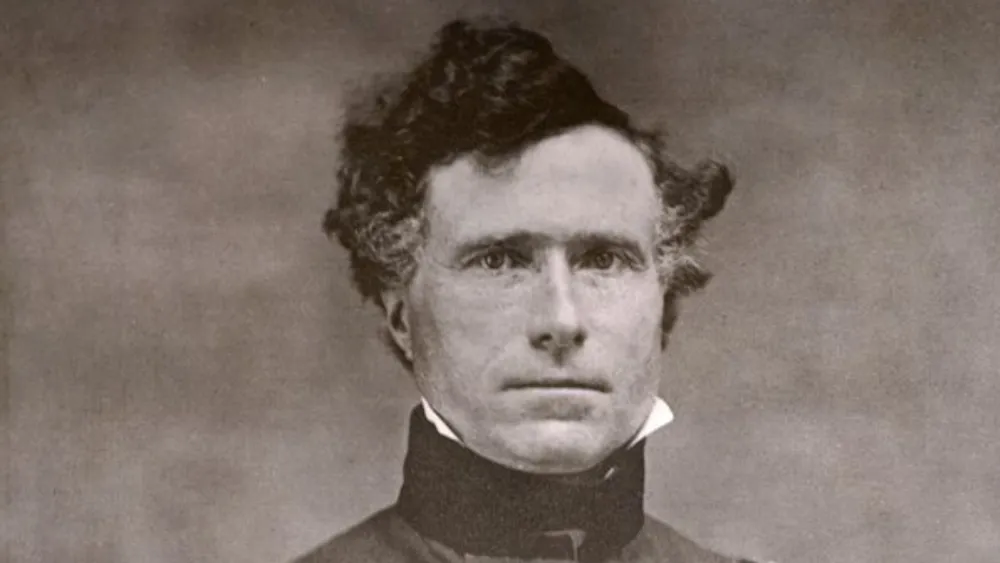Franklin Pierce, the 14th President of the United States, was a Northern Democrat facing the unruly era leading to the Civil War.
Born in New Hampshire, Pierce served in Congress and the Senate and gained recognition for his role in the Mexican-American War.
Elected as a compromise candidate, he aimed for unity but faced challenges enforcing civil service standards.
Despite successful land acquisitions, Pierce’s support of pro-slavery measures, like the Kansas-Nebraska Act, led to widespread criticism.
As the nation plunged into war, Pierce’s legacy became marred, leaving historians to deem him one of the least memorable and worst U.S. presidents.
Franklin Pierce: Roots and Ancestry
Franklin Pierce was born on November 23, 1804, in a log cabin in Hillsborough, New Hampshire. He was a sixth-generation descendant of Thomas Pierce, who had moved to the Massachusetts Bay Colony from Norwich, Norfolk, England, in about 1634.
His father, Benjamin, was a lieutenant in the American Revolutionary War who moved from Chelmsford, Massachusetts, to Hillsborough after the war, purchasing 50 acres (20 ha) of land. Pierce was the fifth of eight children born to Benjamin and his second wife, Anna Kendrick; his first wife, Elizabeth Andrews, died in childbirth, leaving a daughter.
Benjamin was a prominent Democratic-Republican state legislator, farmer, and tavern keeper. Pierce’s father was deeply involved in state politics during his childhood, and two of his older brothers fought in the War of 1812; public affairs and the military were thus major influences in his early life.
Educational Foundations: Early Years in Hillsborough Center
Pierce’s father prioritized education for his sons, enrolling young Franklin in a school at Hillsborough Center during childhood.
At the age of 12, he was sent to the town school in Hancock. Despite his father’s efforts, Pierce, not particularly fond of schooling, experienced homesickness and once walked 12 miles back home on a Sunday.
Upon his return, his father provided dinner but insisted he walk the remaining distance back to school in a thunderstorm, a moment Pierce later deemed “the turning point in my life.” In the same year, he shifted to Phillips Exeter Academy to prepare for college. Then, he established a reputation as a charming yet occasionally mischievous student.
Academic Determination: Rising from the Bottom of the Class
In the autumn of 1820, Franklin Pierce began his academic journey at Bowdoin College in Brunswick, Maine, joining a group of 19 freshmen. Participating in the Athenian Society, a progressive literary group, Pierce cultivated lasting friendships with notable figures like Jonathan Cilley and Nathaniel Hawthorne.
Despite starting at the bottom of his class after two years, Pierce committed himself to academic improvement, ultimately graduating in fifth place out of 14 in 1824.
His college years were marked by a budding political alliance and subsequent rivalry with John P. Hale, as well as leadership of the Bowdoin Cadets, an unofficial militia that stirred controversy and led to a student strike.
In his final year, Pierce gained valuable teaching experience at Hebron Academy in rural Maine, earning both his first salary and the admiration of future Congressman John J. Perry, one of his students.
Franklin Pierce: Overcoming Setbacks
After a brief stint studying law with family friend and former New Hampshire Governor Levi Woodbury in Portsmouth, New Hampshire, Franklin Pierce continued his legal education. He attended a semester at Northampton Law School in Massachusetts. Then, in 1826 and 1827, he furthered his studies under Judge Edmund Parker in Amherst, New Hampshire.
Admitted to the New Hampshire bar in late 1827, Pierce commenced his legal practice in Hillsborough. Although his first case caused him a setback, Pierce quickly demonstrated his legal acumen.
Despite not being a legal scholar, his excellent memory, personal charm, and resonant voice contributed to his success. In Hillsborough, he partnered with Albert Baker. Baker had studied law under Pierce and was the brother of Mary Baker Eddy.
Franklin Pierce: Commitment to Militia and Reform
By 1824, New Hampshire’s political landscape was marked by intense partisanship, pitting Democrats like Woodbury and Isaac Hill against Federalists led by President John Quincy Adams.
In 1827, the Democratic Party gained traction by endorsing General Andrew Jackson. Benjamin Pierce, their pro-Jackson nominee, secured the governorship uncontested.
Meanwhile, Franklin Pierce, aspiring to be an attorney, found himself deeply immersed in politics.
Elected as Hillsborough’s town meeting moderator, he actively campaigned for Jackson. Then, he won his first legislative seat in 1829. Rising swiftly, he became Speaker of the House in 1831. Therefore, it shaped his political stance against banking expansion.
Despite early success, Pierce longed for a life beyond Hillsborough. His militia service, rank advancement, and efforts to revitalize state militias reveal his commitment.
Nominated for the U.S. House of Representatives in 1832, Pierce’s political journey continued amid a shifting political landscape.
Jane’s Whig Roots and Pierce’s Democratic Ties
Franklin Pierce’s marriage to Jane Means Appleton in 1834 brought together two individuals with starkly different backgrounds.
Jane, the daughter of a Whig family, contrasted with Pierce’s Democratic affiliation. She was reserved, deeply religious, and a strong advocate for temperance, urging Pierce to avoid alcohol.
Constantly ill with tuberculosis and psychological ailments, Jane detested politics and Washington, DC. This fate caused an ongoing tension in their lives.
The couple relocated to Concord, New Hampshire, in 1838, as Jane disliked their initial residence in Hillsborough.
Tragically, all three of their sons – Franklin Jr., Frank Robert, and Benjamin – succumbed to childhood illnesses and accidents. It cast a shadow over their family life when they passed away.
Declining Polk’s Offer and Leading the 9th Infantry
During the Mexican–American War, Franklin Pierce realized a long-held dream of active military service. Inspired by his father, brothers, and brother-in-law’s service, Pierce, a former legislator and militia officer, volunteered when war was declared in 1846.
He declined the offer to become Polk’s Attorney General to fight in the war, appointed commander of the 9th Infantry Regiment in 1847.
Promoted to brigadier general, his brief term elevated his public image, despite injuries and accusations of cowardice.
Pierce led his brigade, facing perilous journeys and injuries, eventually participating in the capture of Mexico City. Ulysses S. Grant, who observed Pierce, praised his courage, countering later allegations.

Franklin Pierce: Foreign Affairs Milestone
Influenced by the expansionist Young America movement and led by Secretary of State Marcy, the Pierce administration aimed to project a uniquely American image on the world stage. Marcy advocated for a simple American attire for diplomats, rejecting elaborate European uniforms.
Furthermore, the administration received international acclaim for defending Austrian refugee Martin Koszta.
Davis, supporting a southern transcontinental route, sent James Gadsden to Mexico to buy land for a potential railroad. Gadsden negotiated a treaty and purchased a significant portion of land in the southwest.
Although Congress reduced the acquisition’s scope, the Gadsden Purchase extended the United States to its current boundaries, marking a key moment in foreign affairs.
Leadership Lessons from Franklin Pierce
Franklin Pierce’s journey offers lessons in leadership amid political strife, resilience in personal tragedy, and the impact of ideological differences.
His military service illustrates courage in the face of criticism, while diplomatic decisions showcase the complexities of foreign affairs.
Pierce’s legacy prompts reflection on the enduring consequences of political choices, enriching our understanding of historical figures.











